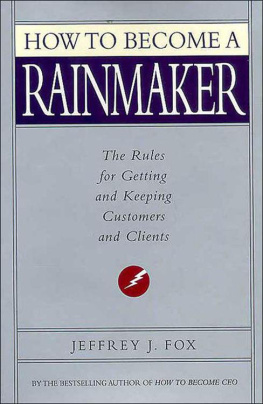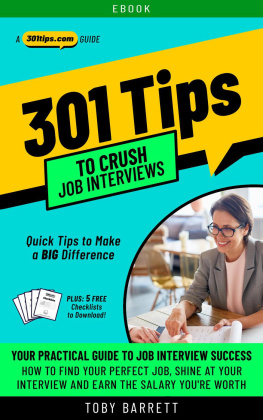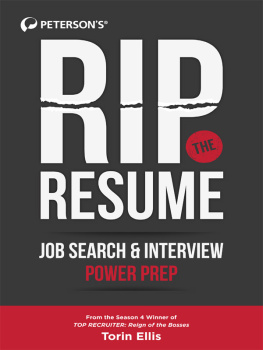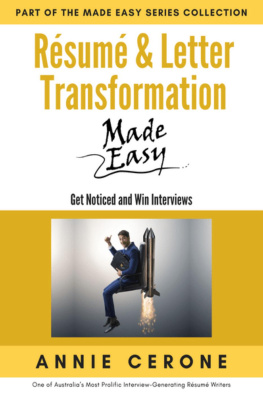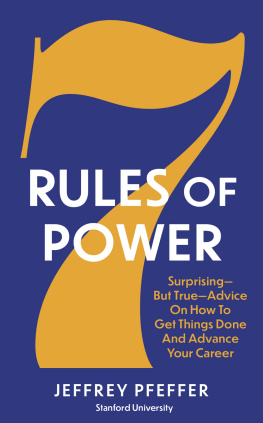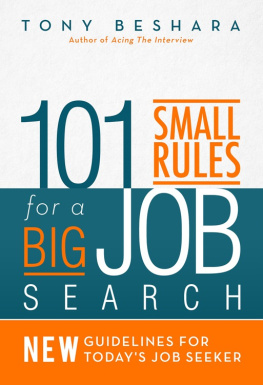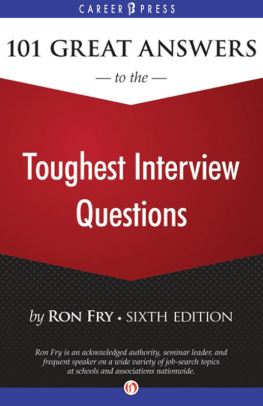JEFFREY J. FOX
CONTENTS
I
Dont Send a Resume
II
Why Resumes Dont Sell
III
The Job-getting Blueprint
IV
Skip the Personnel Department
V
The Job Seekers Marketing Mix
VI
The Job Seekers Glossary
VII
You Are a Box of Cereal
VIII
Always Dollarize Yourself
IX
Draw a Forty-mile Circle
X
How to Research a Target Company
XI
Look Where They Aint
XII
Write an Impact Letter
XIII
Write Boomerang Letters
XIV
Send a Resu-letter
XV
Be a Fish out of Water
XVI
Dont Play Resume Roulette
XVII
Nontraditional Clues for Writing a Resume
XVIII
No One Cares about Your Job Objective
XIX
Dont Play Whats My Line?
XX
The Job Interview Is a Sales Call
XXI
Answer the Question, Why Should This Company Hire Me?
XXII
Always Have a Sales Call/Job Interview Objective
XXIII
Precall Plan Every Job Interview
XXIV
Job Interview Precall Planner
XXV
No One Cares What You Like
XXVI
Great First Interview Questions
XXVII
Dont Talk in an Interview
XXVIII
Handling Interviewer Concerns
XXIX
Show Something on Every Interview
XXX
Ask to Do a Demonstration
XXXI
Dont Order Linguini with Marinara Sauce
XXXII
Look Like a Ballplayer
XXXIII
Make Them Feel Good
XXXIV
Flatter and Wow Them with Your Interest
XXXV
How to Play Parlor Games
XXXVI
Always Ask for the Order
XXXVII
Always Send a Thank-you Note
XXXVIII
Get Five Points Every Day
XXXIX
Keep a Daily Job-hunting To-do List
XL
The Job Seekers Workday
XLI
Never Panic
XLII
Dont Ask for Directions
XLIII
I Is a Bad Word
XLIV
Wind Me Up at Harvard!
You are reading this book because you now are looking for a job or are about to look for a job. You are just starting your search or have been in the job market for some time. You probably have anxiety; thats OK. You probably own or have read other books on getting a job, and thats OK. Some of those books are helpful and important. But this book is different. This book is about marketing and sellingthe marketing and selling of yourself. Marketing and selling are business disciplines that many people havent learned. These people may be students, manufacturing experts, accountants, lawyers, research scientists, human resource professionals, meeting planners, moms reentering the workforce, retired military personnel looking for a second career, fired CEOs, and even sales and marketing types.
Countless good people who are looking for a jobpeople who could make a positive contribution to any number of companiesare rejected daily by countless organizations. Why? One reason is that they look for a job the old-fashioned way. They rely on resumes and networking to land a job. They follow the same old, same old job-getting formula.
With some variation, the old formula is: Read books on how to get a job and how to write a resume and how to network, or get with an employment agency or outplacement firm. Then write a brilliant resume, write a compelling cover letter, print everything on exquisite stationery, mail resume and cover letter to the human resource departments of the Fortune 1000 (or some other list), take how to interview training, clear the calendar for the interviews. Finally, go to the mailbox, and from those companies that bothered to respond, read rejection form letters.
Microsoft doesnt sell software by sending a flyer to ten million people and having employees call old contacts. Budweiser doesnt sell beer that way, and Procter & Gamble doesnt sell soap that way. Instead, the great marketing companies invest in innovation, create differentiated products, tailor the products to fill specific customer needs, and package and promote the products with clarity.
Every day, hirers in organizationsyour customers, the buyers of yousee the same phrases in resume after resume. Every day, people on the network get replicated letters, ghostwritten by outplacement firms, from job seekers they dont know. Every day, potential hirers or influencers get resumes with cover letters that misspell their names. Every day, active hirers, or people with current hiring needs, get resumes and cover letters that contain nothing that is red-hot relevant to them. And every day, someone who is generous enough to meet a job seeker will hear that job seeker start the interview: So what does your company do?
Do the skills-listing and self-analysis exercises in the other job-getting books. Understand your inner self, your drives, and your good and bad karma. Write down all your pros and cons.
Then do whats in this book and you will land your dream job, the one most suited to you. This book may not cut the time of your job search, but it will definitely reduce time wasted.
I
Dont Send a Resume
A resume with a for everyman cover letter is junk mail. A resume without a cover letter is used to line the bottom of the birdcage. Most direct mail hits the trash barrel between the mailbox and the house. All unexpected and standard resumes go from the IN box to the trash box. Some may generate a rejection form letter; most get ignored; 99.2 percent get tossed.
When a salesperson calls on a customer without an appointment it is a cold call. Cold calls have a low success rate. The customer may have absolutely no need for the product, may not even be in the office. Telemarketers who call at dinnertime have a low success rate. The customer may be too busy to talk, may have absolutely no need for the product, or may not be home. Resumes that arrive without invitation have a low success rate. The person who receives the resume may have no need for an additional employee, may not even be the hiring person.
You are the product, and your resume is your sales literature. Super salespeople never send literature before meeting with a prospective customer. They know that sales literature sent prior to a needs analysis is odds-on to be irrelevant, off target, and unread. Super salespeople send literature after the first interview or bring it with them on follow-up calls. If the literature is not completely customized to the customers needs, the salesperson highlights those product benefits most meaningful to the customer. Super salespeople create interest in their product and use sales literature to reaffirm and to leave a footprint, a product remembrance.



